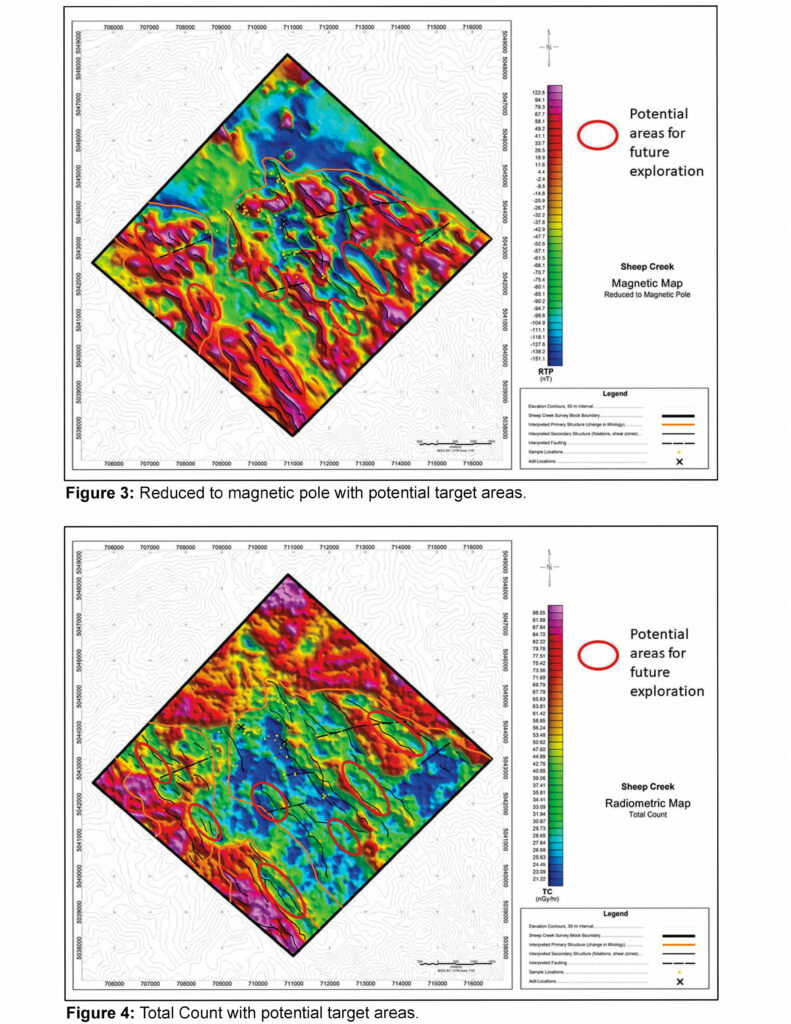New geophysical surveys identify potential source of the high-grade rare earths found on the surface at Montana project.

A pair of recent geophysical surveys has identified a potentially larger source of the high-grade rare earths, gallium, niobium, and other critical minerals found on the surface at U.S. Critical Materials Corp.’s Sheep Creek project in southwestern Montana.
Long known as a potential domestic supply of niobium, which is a critical ingredient in high-strength steel alloys for pipelines and structural applications, Sheep Creek has reemerged as a promising source of at least 13 minerals critical to the United States.
While rare earths, gallium, scandium, and yttrium were first discovered at Sheep Creek when the project was being explored for niobium in the 1960s, there were very few uses for these novelty metals at the time. Six decades later, however, this group of tech metals has been elevated onto the U.S. critical minerals list due to their uses in electric vehicles, computer chips, high-strength alloys, and a plethora of other high-tech and consumer devices.
With the demand for these critical metals growing, along with the American government and manufacturers seeking to diversify supplies away from China, U.S. Critical Materials Corp. acquired this 4,500-acre property known to host more than 50 rare earths enriched carbonatites – igneous rocks that often host high concentrations of rare earths and other critical minerals.
U.S. Critical Materials has confirmed the high-grade nature of the project.
Samples collected by the company so far contain as much as 18% total rare earth elements. What is particularly intriguing is the high percentage of neodymium and praseodymium, a pair of rare earths that are used in the powerful magnets that go into EV motors, wind turbine generators, and a wide range of other high-tech and household goods. Samples with as much as 2.4% combined neodymium and praseodymium have been collected from the Sheep Creek carbonatites.
Now, a geophysical survey commissioned by U.S. Critical Materials has provided evidence that the dozens of rare earths-enriched carbonatite dykes found on the surface at Sheep Creek could be linked to a deeper, and potentially much larger, source.
“The concentration of carbonatite dikes in a relatively restricted area suggests the possibility of an underlying common source and the probability of additional undiscovered carbonatites,” Precision GeoSurveys, the company that did the work, inked in an Oct. 2 report.
Two Geophysical Surveys
Geophysical surveys such as the ones Precision flew over Sheep Creek utilize various sensing techniques and equipment to identify rock characteristics, which provides a picture of the geology below the surface.
Two geophysical surveys, magnetic and radiometric, were flown over the rare earths enriched property.
The magnetic survey flown over Sheep Creek allows geoscientists to “see through” nonmagnetic rocks and cover such as vegetation, soil, and water to identify magnetic anomalies that reveal geological features and potential accumulations of metals within the Earth.
The radiometric survey identifies natural low-level radiation in rocks and soil, which provides clues to the type of mineralization that lies below.
These are the same types of surveys the U.S. Geological Survey is flying as part of its Earth Mapping Resources Initiative to identify domestic sources of critical minerals. USGS plans to fly Earth MRI scans over the area of Montana where Sheep Creek is found, however, these higher altitude surveys will be slightly lower resolution than those flown by Precision.
Together, these high-resolution surveys have identified seven priority areas for further exploration.
After flying the magnetic survey, it was quickly recognized that the highest-grade rare earths samples collected from the surface, as well as in the underground adits dug during the historical niobium exploration, lie along margins between the magnetic highs and the magnetic lows.
“[T]here appears to be several unexplored areas that show similar magnetic features,” Precision penned in its report.
In addition, high-value samples appear to occur in areas with relatively low radiometric signal.
“Unlike many other rare earth deposits, Sheep Creek also contains low amounts of thorium and therefore has a limited radiometric signature, making the targets at Sheep Creek easier to identify,” Precision wrote.

“Areas that may have the highest potential for future exploration fall adjacent to the magnetic highs and occur where the radiometric signal is decreased,” the geophysical firm added.
While the surveys have identified several near-surface targets for discovering dykes or swarms of dykes enriched with high-grade rare earths, U.S. Critical Materials geologists are even more excited to investigate the indications of a deeper body feeding the surfacing carbonatites at Sheep Creek.
“Geology and geophysics indicate that the carbonatites extend down considerably and there is strong evidence that they connect at depth,” Precision wrote.
Armed with the new geophysical data, U.S. Critical Materials geologists are narrowing down targets for future drilling at Sheep Creek.
By Shane Lasley, Metal Tech News
Also published on MetalTechNews: Evidence of larger Sheep Creek REE deposit
